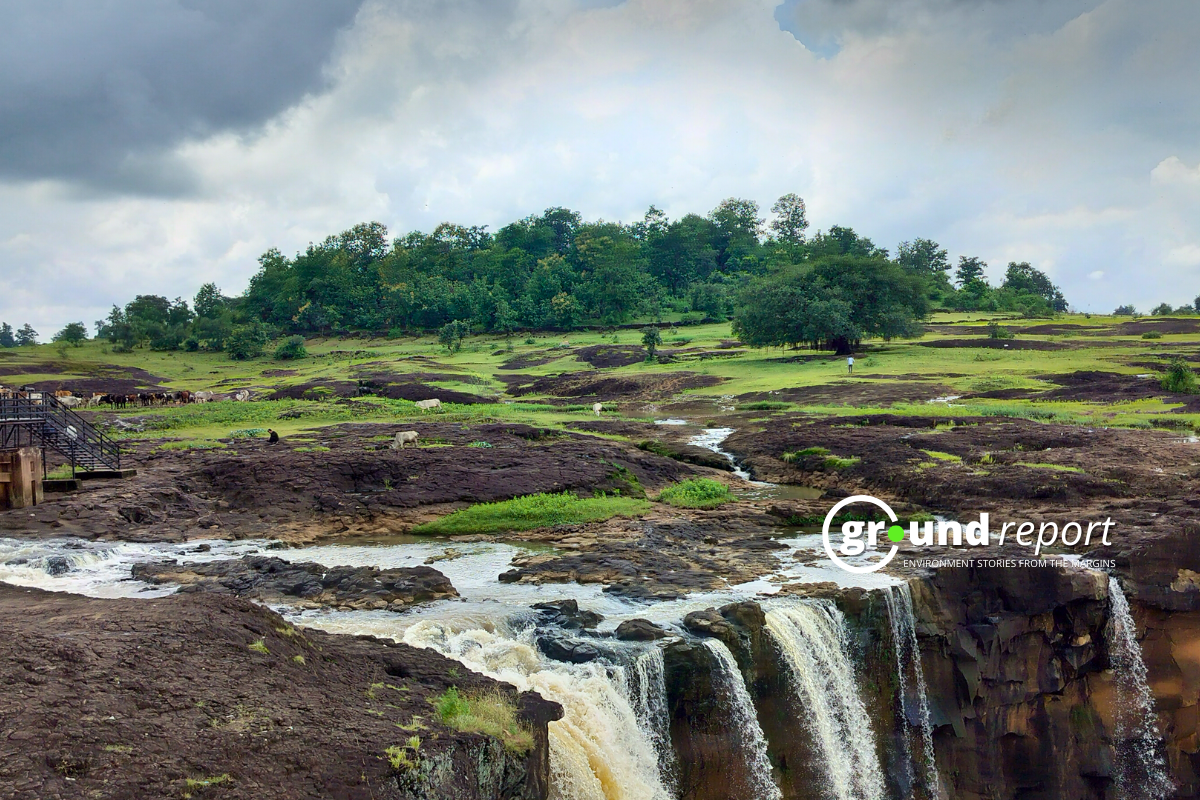Shanti Bai, along with her neighbours, wakes up early in the morning at 4 o’clock to walk for around 3 km to fetch water from a small dam–Maida Bahara. This is the only source of water when all water bodies in her village dry up and Har Ghar Jal Yojna is not functional.

According to the Jal Jeevan Mission dashboard, out of 463 households- 383 have received functional tap water connections. But in reality, the households with tap connections never received water supply. Adding to the distress, the work under the Har Ghar Jal scheme stopped five to six months ago in the Kharghahna village of Bajag block in the Dindori district, due to non-payment to contractors and lack of actions by the authorities.
Deepak Deshmukh, a contractor for the implementation of the Har Ghar Jal Yojna informed NDTV,
“I had taken a contract for a village, did the work but till now only 40 per cent has been paid. Now we are chasing the engineer, no agreement has been made, this is the condition in every village. I had raised money on interest from the market but I am facing problems.”

The population of 3,000 residents in the village rely on the dam for water, other than a few functional hand pumps with dirty water. Sometimes the situation is so dire that villagers–particularly women– are forced to collect water from a small water puddle, a kilometre away from their homes when they cannot go to the dam.
“Only two hand pumps are working, the entire village gathers around them. We have to walk every day along with our children to fetch water,” Shanti Bai added.
The wells in the village have also gradually dried, with little or no water now. Out of 15 wells analysed in Dindori district of Madhya Pradesh, 10 wells show a fall up to 2 metres within just a year (between January 2022 and January 2023), according to the Ground Water Year Book – Madhya Pradesh.
“Didi, you will not even wash your hands with the water we drink,” Shanti bai said while describing the unclean water they drink.
Non-functional Har Ghar Jal Yojna
For years, the residents have been compelled to obtain their water from wells and other sources. They said they were hopeful that this scheme would put an end to their long-standing battle for water.
“We walk every morning up to 1-2 km to the dam to wash clothes and fetch water. The water from the hand pump at a 400-metre distance, is polluted and can not be used for drinking” Santosh Rajput, a resident of the village informed Ground Report.
Santosh Rajput and his family own farmland of 20-25 acres. He hopes for timely rainfall to start sowing seeds on a field which is currently parched, and barren as the village is already facing the water shortage. Santosh’s family relies on agriculture as their main source of income.
According to him, the Jal Jeevan Mission was started with a positive attitude, but at the ground level, the implementation has failed. The villagers have tried to reach out to the district magistrate to voice their concern but they have not received any response yet.
“Once the pipelines were laid, the Public Health Engineering (PHE) department and the contractors for the scheme did not care to supply water,” Rajput added.
In Dindori district, agriculture and forest are the prominent land use aspects. Crop landforms 57% and forest area forms 37 % of total area followed by fallow land (3%), shrub land and just 1% of water bodies. And the villagers, and panchayat feels, therefore the district is undergoing the crisis of both accessibility and availability of the water.
The district’s average rainfall is nearly 1450.00 mm. The Shahpura block receives highest rainfall of average of 1320.00 mm, whereas the Bajag block receives least rainfall in the district of average 990.00 mm.

Negligence by the authorities
According to the villagers, the people in the panchayat own their private borewells. And, do not take the necessary actions to provide water to the residents. However, Gram Panchayat president Gobardhan Sahu expressed his concerns about the lack of funds to dig borewells. Earlier, PHE dug 5-6 borewells for 100-200 ft. in the village over the last three years which failed.
“All the water sources within the village have gradually dried up. Soon the machines to clean the mud from existing borewells will arrive,” said Sahu.
Amidst the water shortage and troubles in the implementation of the Har Ghar Jal scheme, villagers informed us about mismanagement. As per them, the contractors say that they have finished the work for the amount of funds they received. They have not received any further payment to carry out the remaining work.
When the handpumps, borewells and the scheme failed in the area, the villager’s demand for water through tankers was met with excuses from the panchayat.
“When we asked for regular tankers for water supply, the panchayat said the tyres of the tankers are punctured or any other such excuse,” informed Rajput.
Earlier, we reported on delays in the implementation of the Har Ghar Jal scheme and the gap between the on-ground reality and the data on the Jal Jeevan Mission dashboard from Tikamgarh district in Bundelkhand region of Madhya Pradesh. As the heatwaves increase, and the water crisis looms in the country, lives of the most marginalised hang in balance.
Keep Reading
Indian agriculture household earns just Rs. 10,218 in a month: Govt
Post-harvest losses still high, reveals data shared in Lok Sabha
Khadi Haat village’s power-free wastewater treatment solution and more
Support us to keep independent environmental journalism alive in India.
Follow Ground Report on X, Instagram and Facebook for environmental and underreported stories from the margins. Give us feedback on our email id greport2018@gmail.com.
Don’t forget to Subscribe to our weekly newsletter, Join our community on WhatsApp, and Follow our YouTube Channel for video stories.











